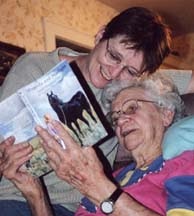That is my Uncle Gene in the middle, and it's me he is holding. Left to right:
Sonja Elkins, Gayle Elkins, Gary Elkins, Gene Elkins, Janet Muirhead, Evan Elkins, Duane Muirhead, Joan Muirhead.
The winter day was bitter cold. Grandpa, Clarence Claud Elkins, was at the homestead near Milner with all of his school age children except Hazel. She was in Steamboat Springs being doctored for a broken leg. Grandma, Maude Elkins, was with her. The preschoolers, Marvin and Martha were there as well, while
she tended to her eldest daughter at her brother, Claude Luekens's home.
A few minutes out in the subzero wind to hitch the horses to the sleigh was enough to convince Grandpa that it was too cold for the little ones to venture out. But it was his turn to drive the neighborhood children to school. So he left Gene (who was 8 or 9) and 6-year-old Dorothy in the warm house while he took Carrol (age 10 or 11) and the neighbors who wanted to go to school. He gave the little ones strict order to stay indoors and out of trouble. He put Gene in charge of keeping Dorothy safe.
Gene felt quite grownup with the responsibility he'd been given. When Dorothy expressed fear (probably of lions and bears) Gene reassured her by getting the gun from his parents' bedroom. "I'll take care of you," he said. The creaking of the house in the wind produced more fear, and Gene told Dorothy it must be a mountain lion trying to get into the attic where it was warmer. She was terrified. There was a hole in the ceiling around the stove pipe, and it was through there that Gene said he would shoot the offending lion.
As he was climbing up to get a shot, the gun accidentally discharged, hitting Gene's knee. He fell to the floor in great pain, bleeding profusely. He told Dorothy to run to the neighbor across the field for help. She didn't want to leave the house, but was convinced that her brother would die if she didn't. She ran out without coat or hat.
Luckily for her, the neighbor was looking out her kitchen window and saw Dorothy coming. She sent her son to run and meet her with coat, hat, and mittens. Dorothy gasped out her story as best she could. The neighbor lady sent her son on horseback to go meet C.C. while she went to see about Gene, taking Dorothy with her. When Grandpa, on his way back from delivering children to school, heard the awful news, he ran the team the rest of the way home. The neighbor had staunched the bleeding and wrapped the wound. Grandpa wrapped Gene and Dorothy in warm coats and blankets, nestled them in the hay on the sleigh, and drove them to Steamboat.
There, in Uncle Claude's house, Gene was put in a bedroom to be treated by the same doctor who had set Hazel's leg and put her in traction. Uncle Claude, after getting them settled, said, "Don't tell Maude," thinking another trauma to her children would be more than she could take. She entered the room saying "Don't tell Maude what?" And someone blurted out, "Oh, Gene shot himself, but don't worry." And thus she received the news that they feared would be too much for her. However, they had underestimated Grandma's strength and courage which she exhibited over and over again during her life.
The doctor dressed Gene's wound and told him to stay in bed and not move his leg. The doctor said Gene would always have a limp. When the doctor came to check on him days later, he was sitting on the side of the bed, swinging his leg back and forth. "What are you doing?" the doctor exclaimed in alarm.
"I'm working my knee," Gene told him. "I'm going to play football someday, so I've got to keep it from getting stiff." The doctor didn't argue, and indeed, Gene did not have a limp and he played football all through high school.



